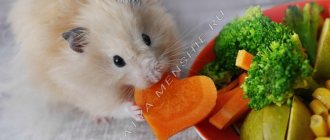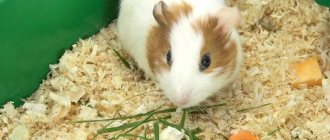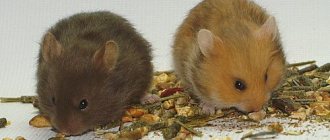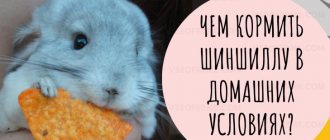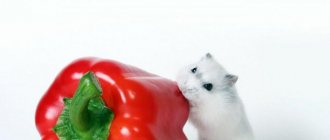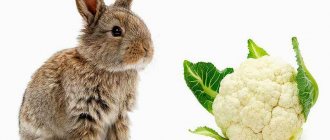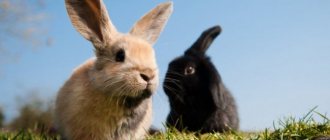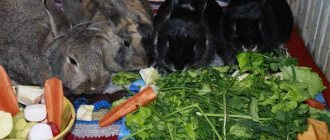Choosing the right diet for your pet is the key to its health and good mood.
In this article, we’ll look at what to feed your Syrian hamster at home and make a list of healthy and unhealthy foods. The list will help inexperienced owners quickly navigate and create the ideal menu for the baby. Let's also look at what can be given to a Syrian hamster, and what it should absolutely not be fed.
What to feed a Syrian
In the wild, the diet of hamsters includes cereals, fresh fruits, vegetables, berries and herbs, as well as food rich in proteins - worms, small insects, and sometimes mice.
At home, organizing your hamster's nutrition will not be a hassle.
The basis of the diet is grains. You can purchase cereal mixtures at a pet store. Special mixtures contain wheat, oats, corn, millet, sunflower seeds, peas, peanuts, buckwheat, peanuts, sesame and more. These products are necessary to replenish the necessary energy and maintain the health of the rodent.
Pay attention to the amount of nuts and seeds in the mixtures. The volume of these components should be minimal. Nuts and seeds contain large amounts of fat. Excessive consumption of this mixture contributes to an increase in fat mass, which will negatively affect the baby’s health.
You can prepare cereal food yourself. You can add pumpkin, watermelon and melon seeds to this mixture. The amount of ingredients can be adjusted depending on the pet's preferences.
Add fresh greens to your rodent's diet daily: plantain, burdock, green salad, dill, parsley, clover, knotweed, nettle (processed with boiling water), wheat germ, oats and other seeds.
You can add dandelion, wormwood and tarragon to the food with caution.
If you collect grass yourself, choose places far from the road, for example, in a summer cottage. Before letting your pet eat grass, rinse it thoroughly and dry it.
Fresh branches of fruit and deciduous trees are necessary for the rodent to grind down its constantly growing teeth. Hamsters can be given branches of the following trees: apple, maple, poplar, pear, cherry, ash, birch and some others.
Cut the twig in environmentally friendly places and treat the treat before feeding: rinse and remove twigs.
Hamsters enjoy eating nutrient-rich vegetables. It is recommended to feed rodents with carrots, cucumbers, pumpkin (without peel), sweet peppers, zucchini, radishes, turnips and beets. Choose foods carefully before feeding. Vegetables containing chemicals such as nitrates can negatively affect the health of hamsters. Pesticides, even in small quantities, can cause poisoning.
It is not recommended to add fruits with rotten areas to food. Vegetables must be peeled and cut into small pieces. Small slices will be more convenient for your pet to eat.
Sweet fruits contribute to weight gain, so hamsters should not eat them daily. The following fruits can serve as treats for your pet: apples, pears, bananas, peaches and apricots.
Remove seeds and seeds from the fruit, cut into small pieces, peel and feed to your pet in small portions.
In nature, hamsters feast on berries. You can feed strawberries, wild strawberries, raspberries or grapes. Choose ripe fruits and wash them thoroughly.
A small body also needs protein foods. The most useful sources of protein for a rodent are: chicken and quail eggs, boiled chicken breast, low-fat fish, low-fat cottage cheese, fresh green peas, chickpeas soaked in water, insects and worms.
Do not overuse protein foods. The recommended intake is 2-3 protein days per week. Alternate foods.
What to feed the animal
Juicy foods are not enough to maintain water balance in a rodent’s body. It is imperative to place a water bowl in the rodent's cage. It needs to be updated every day.
Proper diet for Syrian hamster
Domesticated Syrian hamsters are not capricious and picky; in the natural conditions of the wild, their relatives eat a wide variety of foods. The menu for domestic rodents should be as close as possible to the natural diet and based on the following components:
- cereal crops;
- succulent plant food;
- protein component.
The easiest and much safer way is to purchase a dry food mixture designed specifically for hamsters. Such compositions can be found in any pet store and even in a large supermarket; it is not forbidden to mix them yourself. However, the use of ready-made food does not relieve owners from the need to give rodents plant and animal food, albeit in much smaller quantities.
Syrian hamsters are usually fed twice a day (morning and evening); they are given no more than 25-30 g of grain mixture (a tablespoon) at a time. Moreover, at the first dose it is better to give a slightly smaller portion, and in the evening the main portion (60-70%). This is explained by the fact that hamsters' activity reaches its highest peak at nightfall (when they expend a lot of calories).
Alternation of feed and products
Veterinarians do not recommend keeping hamsters on dry mixtures alone; they must be alternated with other products (various cereals and vegetables). Instead of food, if it suddenly runs out, you can occasionally give bread (gray, black, rye, with bran, cereals, etc.). Small rodents should not be starved, as they have an intense metabolism, and long breaks in eating are extremely painful and harmful for them. The Syrian hamster is capable of not eating for 2-3 days, but it is still better not to allow such a situation and not to risk it.
What not to give
Rodents are considered omnivores. But some foods cannot be given to hamsters. Feeding hamsters the following foods can cause health problems and even be fatal.
Syrian hamsters should not be given the following foods: fats of any origin, salt, sugar, chemical additives, spices, pine needles, plant bulbs, sour fruits, berries and plants, citrus fruits, cabbage, mint, garlic, most dairy products, berry and fruit seeds, mushrooms , potato sprouts and peels, baked goods, food for birds or other animals, canned food and smoked meats.
The above products should be completely excluded from the animal’s diet. Adequate nutrition is a very important element of a comfortable and long life for a hamster.
How to choose food
The choice of food for rodents is extremely wide; it is extremely important to choose the most optimal composition. A good food grain-cereal mixture for Syrian hamsters should definitely include:
- oats, wheat;
- buckwheat, millet (preferably red);
- corn, shelled peas;
- peanuts, cashews;
- sunflower seed, alfalfa;
- flax, sesame;
- pumpkin seeds, etc.
Ready-made store-bought food intended for hamsters (Syrian and others) contains cereals and grains, with the addition of various seeds. It is welcome if they contain a protein component (sublimated granules: fish, chicken, shellfish, shrimp, veal, yeast, etc.). Many manufacturers add dried vegetables and fruits to feed mixtures, and some even further enrich them with minerals (P, Ca) and vitamins (E, A).
Before purchasing, you must carefully study the entire composition of the product. Ideally it should be like this:
- proteins - no less than 14%;
- fiber - 5-8%;
- fats - up to 8%.
The proportion of fat-containing components (nuts and seeds) should not exceed the recommended amount, since consuming large amounts of high-calorie foods by a hamster can lead to obesity.
High-quality food for Syrian hamsters must meet the following requirements:
- do not contain various dyes, flavor enhancers, preservatives and other artificial additives;
- there should not be any exotic fruits, as well as honey, sugar and salty ingredients;
- all grains must be whole and undamaged, free from dust, dirt, mold and other foreign matter;
- the packaging is sealed, with a good shelf life, without signs of opening or damage (preferably transparent so that its contents can be seen).
It is strictly contraindicated to use store-bought dry food intended for other categories of animals (birds, rabbits, etc.) to feed the Syrian hamster. The composition of these mixtures is designed for a specific type of animal; some components are absolutely unsuitable for hamsters and can cause significant harm (problems with the gastrointestinal tract, etc.).
Pregnant females
When preparing for breeding, you should know that a pregnant female needs:
- boiled chicken meat;
- boiled yolk;
- skim cheese;
- greens, sprouted grains;
- increased amount of protein food: gammarus, earthworms, grasshoppers, butterflies (necessarily purchased in specialized pet stores).
During the gestation period, the volume of feed is increased so as not to cause concern to the mother due to lack of supplies. A piece of coal, a mineral stone, and calcium gluconate are placed in the cell.
Pregnancy lasts about 20 days. 5-15 babies are born. Fertilization of a female should not be allowed before four months.
It is important to provide the mother with peace: there should be no other hamsters in the cage, it is forbidden to pick up small cubs, because a foreign smell can frighten the mother. It is necessary to provide the female with a balanced diet and ensure peace. All this will prevent manifestations of cannibalism on the part of the mother.
Fruits for your hamster
Hamsters can be given various fruits (with the exception of citrus and exotic ones), but in small doses. The high sugar content makes this complementary food unsafe. Domestic Djungarians are given less of it than individuals of the Syrian breed - within 5% of the main diet. Campbell's hamsters are fed even more carefully.
The main fruit products that are suitable for Syrian and Djungarian hamsters include:
- apple - choose sweet and sour varieties, introduce them from 4 months, do not give to lactating females;
- apricot – a little and not overripe, it is better to give dried apricots out of season;
- peach is better than nectarine, it has less sugar;
- pear – firm yellow or green, uncommon;
- banana – preferably a little greenish, just unripe;
- plum - a little at a time, so as not to provoke diarrhea;
- melon – due to excessive sweetness, allowed only once every 5-7 days;
- watermelon - also rare, but from your own garden (it’s hard to find a store-bought one without nitrates).
Berries will help diversify your diet. Strawberries are offered once every 7 days, a piece with a diameter of 1 cm. The rest of the berries from the list are given 1 piece per week, the portion for the Syrian hamster is doubled. Allowed:
- cherries and sweet cherries (pits removed);
- currant;
- not sour gooseberries;
- grape;
- raspberries;
- blueberry;
- blackberry;
- cowberry;
- blueberry.
Of all of the above, only dietary fruits are suitable for Campbell's hamsters. These are nectarine, blueberry, lingonberry, cherry, hawthorn. It is worth remembering that exotic fruits (mango, avocado, kiwi, pineapple and others) are prohibited from being offered to all rodents. They can cause severe allergic reactions and digestive problems.
Composition of the fruit
Apple fruits are considered one of the most common in temperate regions. There are many varieties of apples and all of them are beneficial for the human body. But is it possible to give hamsters apples and how beneficial are they for the small rodent’s body?
The fruits of the fruit tree are a valuable source of ascorbic acid, potassium and iron. In addition to these useful components, the apple contains zinc and copper.
Varieties grown in the southern regions have a moderate content of fructose and sucrose. Apple trees growing in the north produce fruits with high acidity.
Appearance and features
Photo: Syrian hamster boy
Syrian or golden hamsters were bred in laboratory conditions from wild hamsters brought from Syria by zoologists in the last century. The body length of an adult is approximately 13-15 centimeters. Average body weight is 200-300 grams. This species is characterized by sexual dimorphism. Female individuals have a larger and stockier body. At the same time, the body length of females is slightly less than that of males. Another distinctive feature is the shape of the back. In females it is straight, in males it has a pointed shape. Individuals can also be recognized by the number of nipples. Females have four of them, males have only two.
Animals have a specific structure of their limbs. They have 4 toes on their forelimbs and five on their hind limbs. Most individuals of this species are golden in color, but individuals of other colors may occur.
What colors of Syrian hamsters can be found:
- copper;
- chocolate colors;
- sable;
- beige;
- honey;
- dark chocolate color.
The color may be uniform or have spots of a different color. The body of Central Asian hamsters is covered with thick and soft hair. Golden hamsters come in long-haired and short-haired varieties. The hamster's muzzle has a round, slightly elongated shape. There are small, rounded ears on the side of the head. The hamster's eyes are large, round, black, shiny. The nasal part of the animals is framed by whiskers. Hamsters have a small, short tail that is almost invisible in their thick fur.
What grapes are best to give?
Many rodent owners are interested in the question of whether hamsters can eat grapes with seeds and which variety is best to give to their pet. You can choose between red and green grapes, but it is better to choose seedless varieties. The seeds are a choking hazard and should always be removed. Black and blue berries should not be given, as they contain a high sugar content.
There is a very simple way to peel grapes:
- You need to put the berries in a pan of boiling water for a few seconds.
- Then quickly transfer them into the ice-cold water liquid.
- After this manipulation, you can easily remove the peel with your fingers, cut the fruit into pieces and give it to the hamster. The treat for your friend is ready.
Prohibited Products
First of all, you need to exclude any food from the table from the menu. Sauces, mushrooms, sausages, canned food, cookies, cheese, pickled tomatoes, cucumbers, etc. are prohibited. Fruit and berry seeds should not be included in food; they should be removed in advance. They contain hydrocyanic acid, which is toxic to pets.
Nuts are given in small quantities. They are fatty, so they can harm your pet. Brazil nuts are included in the list of prohibited foods along with almonds. The first one is too hard to digest. Almonds can cause poisoning. All sweet foods and sugar are removed from the menu, as hamsters are prone to developing diabetes. Pets are not offered branches of coniferous trees.
The list of prohibited foods includes the following fruits and vegetables:
- melon;
- watermelon;
- citrus;
- avocado;
- grape;
- persimmon;
- mango;
- a pineapple;
- apricot;
- banana;
- kiwi;
- pomegranate;
- fresh peas;
- cabbage (including white cabbage);
- potato;
- garlic;
- onion;
- tomato;
- radish;
- daikon.
Hamsters are not given sorrel, rhubarb, mint, wild garlic and parsley.
Why are cookies harmful?
Hamsters have a very low tolerance for sweets, salty and fatty foods. Especially harmful for Djungarian hamsters, which are predisposed to diabetes. You can occasionally offer your hamster dry, unsalted biscuits. But we are not immune from the fact that even such store-bought cookies contain a lot of harmful additives and chemicals. They have a detrimental effect on the liver and digestive tract of the rodent. Salt, which is very high in crackers, damages the heart and kidneys. As a result, the immune system weakens and other vital systems suffer. A hamster with a cookie looks very cute, crunches funny, and crumbs remain on its antennae. But you shouldn’t risk your pet’s health to admire this picture; it’s better to choose a healthy alternative to the treat.
Social structure and reproduction
Photo: Syrian hamster
Golden hamsters are very prolific animals, provided they are kept in optimal, comfortable conditions. If the temperature of the space surrounding them is maintained at 20-25 degrees, animals will be able to bear offspring almost all year round. Most often, with good care, a sexually mature female individual bears offspring 3-5 times a year. She can give birth to 5 to 9 babies at the same time.
The period of sexual maturity in males occurs at the age of one month, and in females at the age of two months. It is recommended to breed animals to produce offspring after the female has gone into estrus. Otherwise, individuals can seriously fight, even causing injury to each other. If the hamsters like each other, then they mate successfully. The whole process lasts no more than 10 minutes. Pregnancy may not occur the first time. Then a second mating will be required.
Pregnancy lasts on average 17-18 days. When the time comes to give birth, the female goes into the nest or shelter she has made. The mother feeds newborn babies with milk for another month. After the male has impregnated the female, they must be separated, since pregnant females are characterized by aggressive behavior towards their relatives. The owner should also be careful, since during this period the animals tend to bite.
Origin of the species and description
Photo: Syrian hamster
The Syrian hamster is a chordate animal. They are classified into the class of mammals, the order Rodents, the family Hamsters, the genus Medium hamsters, and the species Syrian hamsters. Initially, the name golden hamster was assigned to them thanks to zoologist Georg Robert Waterhouse. On the recommendation of Charles Darwin, he compiled a list of animals that arrived from the expedition on the Beagle. Among the diversity of representatives of the animal world, there was the only representative of this breed.
Video: Syrian hamster
This species of animal was first described by the English scientist, zoologist and researcher George Robert Waterhouse in 1839. The scientist mistakenly considered it an extinct species. This assumption was refuted in 1930, when another scientist Israel Aharoni, during his expedition, discovered a Syrian hamster - it was a pregnant female. The scientist transported this hamster to the University of Judea, where the female safely gave birth to 11 small hamsters. Subsequently, of the entire brood, only three males and the female who gave birth to them remained alive.
Scientists tried in vain to find other individuals of this species in natural conditions. However, they never managed to do this. Then Akhoroni came up with the idea of crossing a female Syrian hamster with a male of a related species. This couple became the progenitors of a new species. Around 1939-40, the resulting offspring were transported to the United States of America. After another 1.5-2 years, scientists finally came to the conclusion that the Central Asian hamsters had become extinct, and there were no more representatives of this species in natural conditions.
In the process of studying Syrian hamsters, it was found that they have a dental structure similar to that of humans, and therefore they were used in laboratory conditions to study dental diseases. To date, scientists have not been able to answer the question of what caused the extermination of this species of animals.
